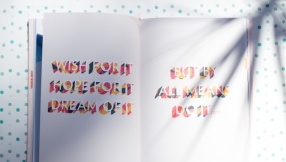Shavuot is the festival which marks the giving of the Torah (613 commandments) to the Jewish people. The festival is a celebration of women. The Torah itself is regarded as female in Jewish thought. The Torah is tough yet compassionate. And because of this the Torah was given to women first.
Last week in Greater Manchester we experienced an attack on female values. Many Jewish girls and women attended the concert, including people I know. The greatest symbol of hope was given by the visit of the Queen to the Children's Hospital. The Queen represents the female values of hope, love, loyalty and determination.

These same values were embodied by Ruth, the Moabite princess, who converted to Judaism and became great-grandmother to King David.
Modesty is a virtue much cherished by Judaism. Ruth herself was modest and so is the religion of Judaism today. It doesn't push or draw attention to itself. By maintaining a quiet and flourishing presence all over Greater Manchester, it contributes and supports the spirit which makes this great city famous all over the world.
Jews have lived in Greater Manchester since 1700. Broughton Park, Salford is presently home to the fastest-growing Jewish community in Europe. What started through small beginnings has now become a quiet force to be reckoned with.
Through Sinai and Ruth three religions developed that have gone their separate ways. Judaism, encapsulated through Ruth the pilgrim, is the matrix from which the two other monotheistic religions have grown.
Ruth is the opposite of ruthless, which is why what we experienced in Greater Manchester last week needs Ruth's qualities to heal the wounds.
Greater Manchester simply wouldn't be Greater Manchester without her Jews and this is realised, if not always openly expressed, by both her religious and civic leaders.
Ruth is the ultimate pilgrim. Tonight, on Shavuot, one of our three 'pilgrim festivals', we are celebrating two events: the giving of the Torah to Moses on Mount Sinai. In Hebrew Sinai means 'tiny bush'. This bush is connected to the story of Ruth. These two events in our history give us guidelines as to how we should live and how we should conduct our lives.
What is Ruth? We used to have a word 'ruth' in the English language, but that has rather fallen by the wayside. Now, as Maimonides said of G-d, we can only know what 'ruth' is from its opposite, 'ruthless'.
What is ruthless?
Ruthless walks all over people, has tunnel vision, believes that the end justifies the means and knows that might is right.
Ruth, on the other hand, is caring, generous, open-hearted, steadfast and, most of all, loyal. Ruth also knows that 'small is beautiful'.
I have known many Ruths in my life and every one has embodied her name. Here are three of these Ruths who have enriched my life.
Scottish Ruth was a Quaker I met at school. She was feisty and different, but always there in a crisis.
Liverpudlian Ruth was the neighbour who welcomed my children into her home and gave them exorbitant amounts of pocket money in exchange for baby-sitting. If not for Liverpudlian Ruth, I would not have founded the Liverpool Burma Support Group, which was the first to publicise the plight of Aung San Suu Kyi and the Burmese people. Without Ruth, I would not have obtained the PhD on which I embarked at the age of 40. I would not have written the book on the great biblical scholar, Abraham ibn Ezra, who left his native Spain in 1139, bringing the fruits of Sefardi culture to northern Europe. He ended his life in England, where he was murdered by Christian pilgrims (or 'anarchic English hordes', as his greatest Israeli biographer has put it) en route to the Holy Land. Ibn Ezra is reputedly buried in Oxford, but his grave has never been found. He inspired Robert Browning to write one of his greatest poems, which starts 'Grow old along with me...'
Jewish Ruth lives in Haifa, Israel's third city, which is situated near Lebanon and Syria, in the north of the country. A bilingual translator, she often used to help with difficult words and phrases when I was her near neighbour and employed by the Haifa Tourist Board as a translator in the immediate aftermath of the 2006 Lebanese War. The local flora and fauna were her speciality.
Of these three Ruths, only one is Jewish, and also Israeli.
You don't have to be Jewish to be good. You don't have to be Jewish to to do the right thing. You don't have to be Jewish to be loyal.
The Ruth we are celebrating today came from a dreadful background. Not only was she from Moab, a country born through incest, which had stabbed Israel in the back a number of times, but she was also a princess, and therefore a torch-bearer for all the negative values which Moab represents. And yet, despite her unpromising beginnings, she chose to be Jewish.
What does it mean to be Jewish? Our Ruth didn't say 'I believe in'. She didn't say 'I believe that'. She didn't say 'I worship'. She didn't say 'I want to be saved', 'go to heaven' or 'see the light'. She didn't aspire to be a bishop or even a rabbi. She didn't worry about which shul she would join. She didn't even become a disciple.
Our Ruth did not follow her mother-in-law, Naomi, because she thought she was perfect. Whose mother-in-law is? What Ruth wanted to become was a pilgrim. She wanted to walk with her mother-in-law to Israel. In Hebrew a pilgrim is someone who walks on foot (holech regel). This concept is related to the word for 'Jewish law' which Moses is also given during the Shavuot festival. That word is 'halakhah'.
Neither walking or Jewish law are static. They involve constant movement – a good word today would be 'evolvement'.
This walking is therefore graceful, but it is walking with purpose: it is physical, mental and spiritual all at the same time. It is not, however, 'walking with attitude'. 'Walking with attitude' is not a pilgrimage: walking with attitude is a crusade. And we all know the outcome of that!
Pilgrimage is therefore a process – and Ruth knew this:
'Wherever you go, I will go. Wherever you lodge, I will lodge. Your people will be my people and your G-d my G-d. Where you die I will die and there will I be buried.'
This isn't about certainty: this is about the unknown. But it is also about Jewish history. Ruth knows that Naomi is returning to Israel. For Naomi this is a going back – for Ruth it is a change of direction. Ruth knows that, along the way, the Jewish people will sojourn in different lodgings – and these won't be the Ritz, the Savoy or even the local pub.
Ruth's lodgings and our lodgings will be all the diaspora countries in which the Jews will be invited to settle throughout their long history and from which they will later, without exception, be banned, have to flee, or in which they will be murdered. As inevitably as day turns to night, Jewish sojourn in diaspora always ends the same way, whether in 500 BCE, 70 CE, 1290, 1492, 1648, 1933 or 2017.
Ruth recognises the importance of community and land. Only by throwing in her lot with the impoverished Jewish people will she come nearer to
G-d. Rather than return as the princess she was in her previous life, she takes the risk – choosing suffering over comfort; moving on rather than remaining stuck in a rut.
By learning the ways and aspirations of her mother-in-law, Ruth replaces all the men in Naomi's life. Naomi had lost husband and sons at a time when male protection was deemed essential. Her story tells us that this need not be so.
The pilgrimage itself was undertaken by two women together, without male protection, at a time in world history, and in an area of the Middle East, which was extremely dangerous, to say the least.
To me this part of the story is even more remarkable than the eventual marriage with Boaz, which leads to the establishment of the House of David – and the Messianic hope.
This story teaches us something wonderful. Even a daughter-in-law from the most unpromising background imaginable can give birth to the Messiah. In fact this is deliberately the case: Ruth may not be an important personage any more, but she has grace.
This Shavuot festival celebrates the ongoing story of the Jewish people – the culmination of our long Exodus from slavery to freedom, in which we receive the ultimate gift – the gift of practical learning, embodied in the female principle of Torah.
This is a female story of survival against the odds and has been an inspiration to women of different religions and ethnicities all over the world.
For as it states in the Midrash on Eshet Chayil (Proverbs 31: 10:29): '"Many women have done valiantly, but you have surpassed them all." This is Ruth the Moabitess.'
Dr Irene Lancaster is Chair of the Broughton Park Dialogue Group in Manchester and an author who has pioneered the teaching of Hebrew and Jewish Studies at a number of universities in the UK.













